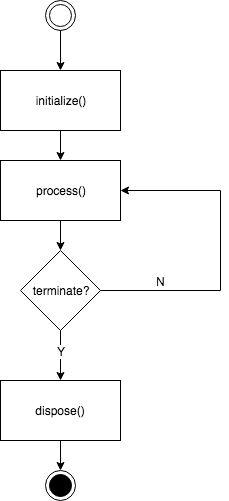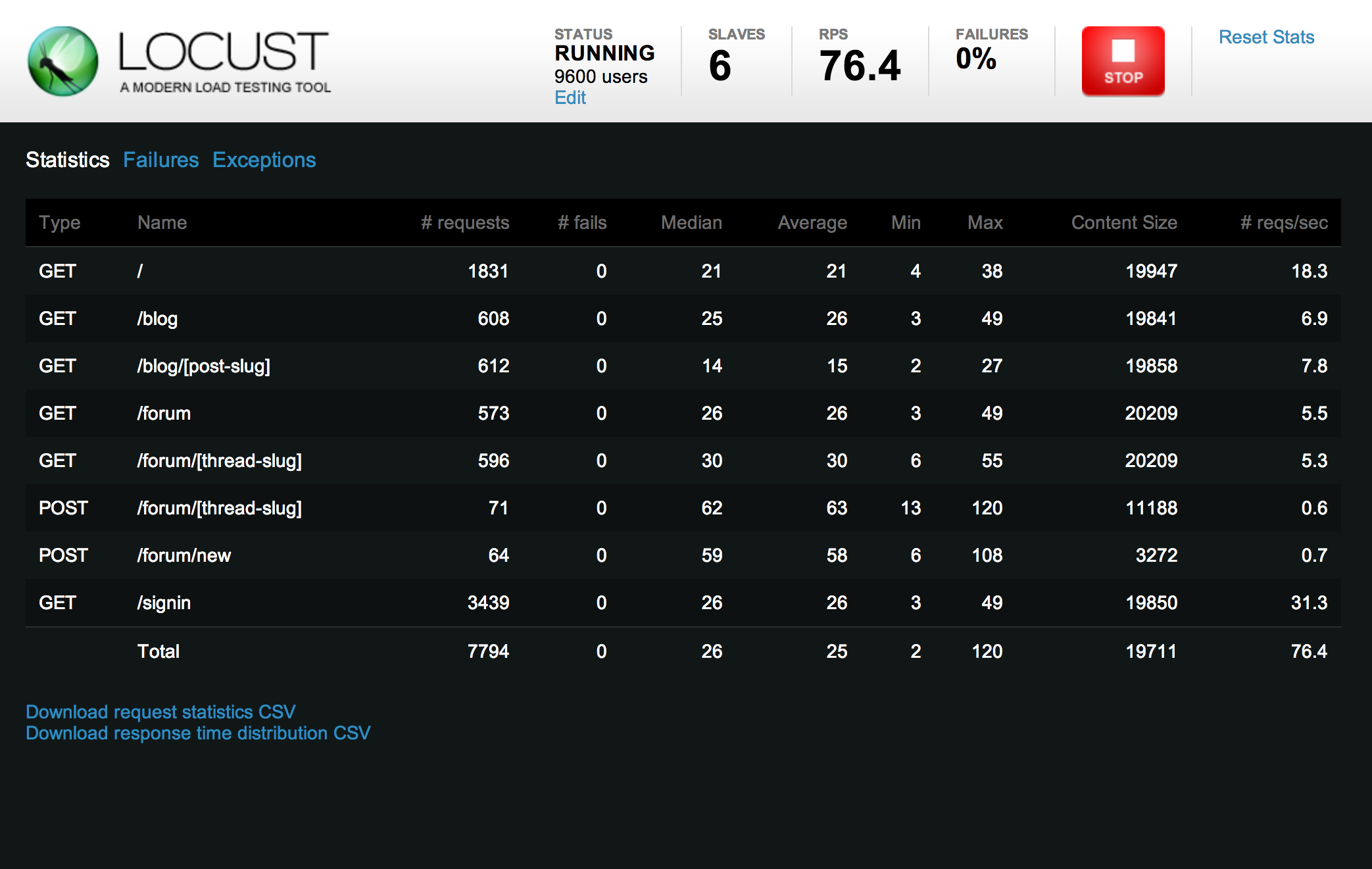An elegant Java client for Locust
IMHO, Locust4j a basic implementation for Locust clients written in Java. It has so many restrictions, including:
-
The code base is not organized well
-
Not so performant with blocking queues
-
AbstractTaskdoes NOT support async operations -
Slow start-up time (mostly by
Utils.getNodeID()) -
Insufficient usage of threading.
Locust4jwill useNthreads to stimulateNusers. A bigNwill result in performance degradation (due to context switching of threads) -
Not well-supported for async operations
Based on implementation of Locust4j, Swarm is completely re-written to address all issues above, with some additional features:
-
Auto detect connection status to Locust master hosts and reponse back.
-
A better model to stimulate concurrent users (with disruptors)
-
LMAX Disruptorfor non-blocking queues -
Google Guavafor rate limiting -
Jeromq+MessagePackfor working with Locust masters
Before using Swarm, you must declare it as a dependency of your Maven project. For example:
<dependency>
<groupId>com.bigsonata.swarm</groupId>
<artifactId>locust-swarm</artifactId>
<version>0.1.1</version>
</dependency>
You also have to add following dependencies:
<dependency>
<groupId>ch.qos.logback</groupId>
<artifactId>logback-classic</artifactId>
<version>1.2.3</version>
</dependency>
<dependency>
<groupId>ch.qos.logback</groupId>
<artifactId>logback-core</artifactId>
<version>1.2.3</version>
</dependency>
<dependency>
<groupId>org.msgpack</groupId>
<artifactId>msgpack-core</artifactId>
<version>0.8.13</version>
</dependency>
<dependency>
<groupId>org.zeromq</groupId>
<artifactId>jeromq</artifactId>
<version>0.4.3</version>
</dependency>
<dependency>
<groupId>com.lmax</groupId>
<artifactId>disruptor</artifactId>
<version>3.3.7</version>
</dependency>
<!-- https://mvnrepository.com/artifact/com.google.guava/guava -->
<dependency>
<groupId>com.google.guava</groupId>
<artifactId>guava</artifactId>
<version>23.0</version>
</dependency>
Swarm uses the term of Cron to refer to repeating tasks defined by you.
Life cycle of a Cron-based instance can be described in the following diagram:
Swarm is responsible for cloning, initializing crons.
// Here is an abridged version of class Cron
public abstract class Cron implements Cloneable, Runnable {
public Cron(Props props) {
this.props = props;
}
public abstract void process();
public abstract Cron clone();
public void recordFailure(long responseTime, String error) {
// ..
}
public void recordSuccess(long responseTime, long contentLength) {
// ..
}
public void recordSuccess(long responseTime) {
// ..
}
@Override
public void run() {
// ...
process();
schedule();
}
public abstract void dispose();
public abstract void initialize();
}Each cron has its own props which defines type & name (to display on the Web interface):
public class Props {
protected String type = "default";
protected String name = "cron";
protected int weight = 1;
protected boolean async = false;
public static Props create() {
return new Props();
}
public static Props createAsync() {
return new Props()
.setAsync(true);
}
public Props setType(String type) {
// ..
}
public Props setName(String name) {
// ..
}
public Props setWeight(int weight) {
// ..
}
public Props setAsync(boolean async) {
// ..
}
}NOTE: A cron must specify how it works: synchronously or asynchronously
Inside each cron, there are 4 must-overridden methods
clone: you should letSwarmknow how to clone your Cron :Dinitialize: It's a great place for you to initiate connections (if you want to use pooling mechanism)process: which is repeatedly executed to perform your tests and report resultsdispose: Swarm will invoke this method to dispose any resources allocated by crons
You need to define your loading test by deriving class Cron:
For example, in our AsyncCron:
public class AsyncCron extends Cron {
private static final Logger logger = LoggerFactory.getLogger(AsyncCron.class);
private MessageSendUser message;
private final int port;
private final String host;
public AsyncCron(String host, int port) {
super(
Props.createAsync()
.setType("grpc")
.setName("push-service")
);
this.host = host;
this.port = port;
}
@Override
public void dispose() {
channel.shutdown();
}
@Override
public void process() {
long startTime = System.currentTimeMillis();
StreamObserver<DataResponse> observer = new StreamObserver<DataResponse>() {
@Override
public void onNext(DataResponse dataResponse) {
long elapsed = System.currentTimeMillis() - startTime;
recordSuccess(elapsed);
}
@Override
public void onError(Throwable throwable) {
throwable.printStackTrace();
logger.error(throwable.getMessage());
}
@Override
public void onCompleted() {
}
};
try {
stub.sendMessage(message, observer);
} catch (Exception ex) {
long elapsed = System.currentTimeMillis() - startTime;
recordFailure(elapsed, ex.getMessage());
ex.printStackTrace();
}
}
@Override
public Cron clone() {
return new AsyncCron(this.host, this.port);
}
ManagedChannel channel;
MessageToUserGrpc.MessageToUserStub stub;
@Override
public void initialize() {
boolean usePlainText = true;
message = MessageSendUser.newBuilder()
.setData(ByteString.copyFromUtf8("Data sample"))
.setUsrid(Long.valueOf("170829000000003"))
.setPushtitle("Apns push test")
.setMsgid(System.currentTimeMillis())
.setMsgtype(4)
.setPushembeddata("f")
.build();
channel = ManagedChannelBuilder.forAddress(host, port)
.usePlaintext(usePlainText)
.build();
stub = MessageToUserGrpc.newStub(channel);
}
}After defining your crons, finally you need to instruct Swarm to start:
Locust locust = Locust.Builder.newInstance()
.setMasterHost(masterHost)
.setMasterPort(masterPort)
// Optionally set the interval (in ms) to report statistics
// Default: 2000
.setStatInterval(2000)
// Optionally set a seed number to generate nodeId
.setRandomSeed(0)
// Optionally set the capacity for our Disruptor's ring
// Note: Must be a power-of-2 number
// Default: 1024
.setDisruptorCapacity(256)
// Optionally set the number of threads used by Disruptor
// Default: 4
.setDisruptorParallelism(8)
.build();
locust.run(new AsyncCron());
// or if you can run multiple crons
locust.run(
new AsyncCron(host, port),
new SyncCron(host, port)
);To effectively benchmark with Locust, we may need to use connection pooling
If you find anything wrong or would like to contribute in any way, feel free to create a pull request/open an issue/send me a message. Any comments are welcome!
v0.1.1
- Released in 20/06/2018
- Fixed a bug in processing hatch rates (PR by @HughZurname)
v0.1.0
- Released in 26/05/2018
- Initial release


